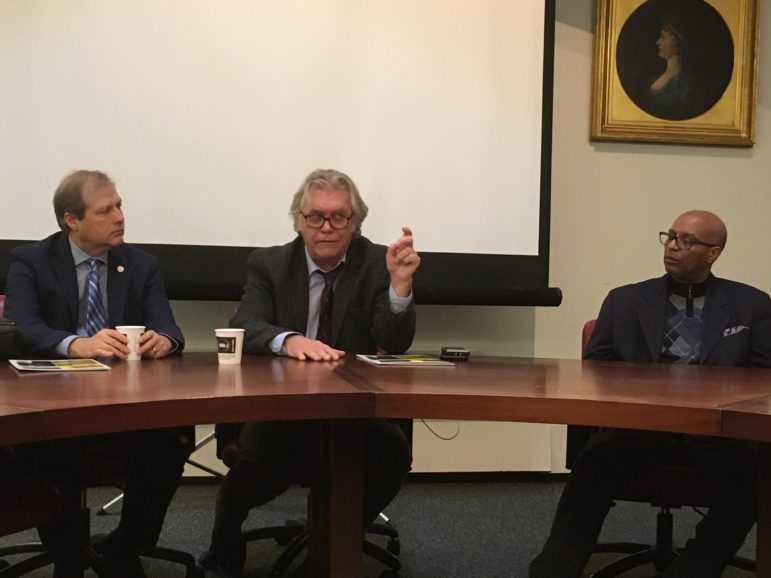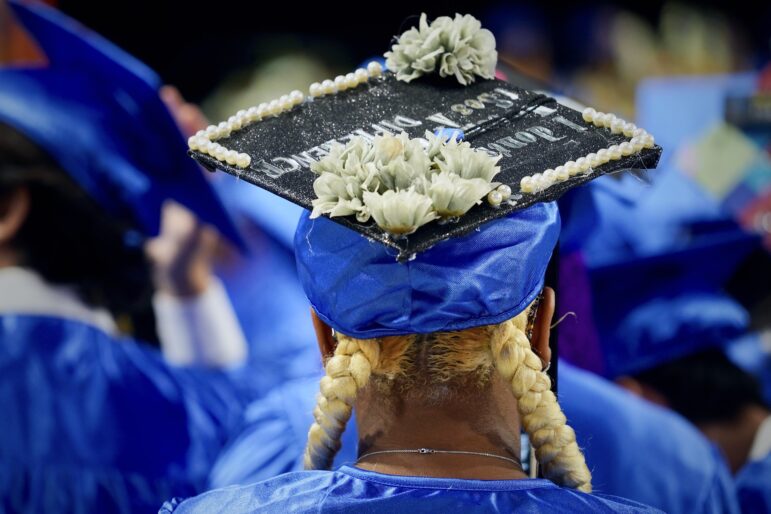
From left to right: Alex Vitale, David Brotherton and Taylonn Murphy.
Traducido por Carlos Rodríguez Martorell
In 2012, the NYPD began implementing “Operation Crew Cut,” which doubled the number of officers in their gang unit, and recreated its “Criminal Group Database” to track alleged gang members. Since then, thousands of youths and adults have been arrested accused of gang affiliation.
A report entitled “Gang Takedowns in the de Blasio Era: The Dangers of ‘Precision Policing,’” published on Thursday, gathered insight from advocates and the defense attorneys of some of the people arrested under the NYPD’s anti-gang efforts.
One of the report’s findings states that, between August 2003 and August 2013, “over 20,000 people were added into the NYPD’s gang database,” of whom 99 percent were non-White. Even more alarming, “30 percent of them were children when added.” In addition, thousands of juveniles and adults were arrested in conspiracy cases, tens of thousands were “placed into a secretive gang database,” and many more were “subjected to harassment, intimidation, surveillance, and threats.”
Most of the increase in gang tracking has been recent. From December 2013 to February 2018, over 17,000 people have been added to this database, and 98 percent of them are black or Hispanic. This figure reflects that the de Blasio Administration has put people on this list at a rate 70 percent higher than the previous leadership.
De Blasio has openly criticized the last mayor for his “stop and frisk” record. But the report suggests anti-gang policing might be just as problematic as stop and frisk: “It appears that the NYPD is merely substituting one set of techniques to tightly manage the lives of young people of color for another and uses the ‘‘gang’ label to mute public opposition.”
The report highlights what it says is the lack of a clear definition of what the police categorize as a “gang” or a “crew” –a smaller, less formal group. “The NYPD gang database can be more accurately described as a database of people that police believe to be grouped together. There is no requirement of a criminal conviction, much less a violent conviction, to being added to the database,” states the report. “It is hard to tell what gangs are real, imagined or manufactured.”
Alex Vitale, one of the authors, told City Limits that “the decision to characterize delinquency in some communities as a ‘gang problem’ is political.”
If determining what a gang is is difficult, figuring out how the police establish a person’s connection to one is also rather vague. According to the report, these are some of the criteria the police say they use:
1) An individual will be entered if they admit to membership during debriefing.
OR
2) Through the course of an investigation an individual is reasonably believed to belong to a gang and is identified as such by two independent sources.
OR
3) Meets any two below mentioned criteria:
• Known gang location
• Scars/tattoos associated with gangs
• Gang-related documents
• Colors associated with gangs
• Association with known gang members
• Hand signs associated with gangs
All these are superficial characteristics, which, according to Vitale, could only “help confirm existing stereotypes about Latinos and African-Americans.” For instance, one factor being widely considered to identify someone’s gang affiliation is posts on social media in which the person admits to being a member of a certain group.
One of the main consequences of being labeled as a gang member by the NYPD is that “your life changes forever. This will affect you when you look for a job or a home, and when you interact with the police,” said Vitale.
The report concludes by stressing that “gang policing replicates the harms of mass incarceration,” and that this form of police control is “simply put, […] racist policing at its worst.” If poverty is recognized as the root of most serious crimes, then “New York City needs to invest in its residents, gang-affiliated or otherwise, instead of criminalizing them.”
John Jay College of Criminal Justice sociology professor David Brotherton stated at the report’s launching that another way to erase the stigma carried by gangs is to legalize them, citing the case of Ecuador: “They legalized their gangs, and murder rates plummeted.”
The report comes after years of concern about massive gang sweeps in which hundreds of young men were arrested and sometimes faced with new gang conspiracy charges based on crimes that had either already been punished or sealed as juvenile offenses.
On Friday’s WNYC Brian Lehrer Show, de Blasio was asked about the concern that inclusion in the gang database might be arbitrary. While de Blasio indicated he did not know exactly how names are added, he nonetheless defended the database:
This database is a central tool in addressing a real problem in this city. Even though crime has gone down for six years in a row, the levels of violence are profoundly less than they were in recent years and decades. We have to remain vigilant and we have a huge amount of work to do, and one of the central ongoing problems in this city has been gangs and crews. So, of course we need to have a systematic effort to address that problem. And I just want to say very clearly to the activists and advocates, if you say should we keep assessing if it’s working, should we keep assessing if it’s handled fairly, should we look at ways we can make improvements – of course. But are we going to give up a strategy that is central to stopping gang violence that is afflicting so many neighborhoods? No, we’re not going to do that.
If you wish to read the report, click here.

NYPD
Image of a ‘gang takedown’ on Staten Island from a 2016 NYPD public-relations film.









One thought on “Report: Gang Policing Replicates the Harms of Mass Incarceration”
It’s ideal opportunity to make a few arrangements for the since quite a while ago run and the time has come to be content. I’ve perused this set up and on the off chance that I could I want to suggest you some eye catching things or counsel. Maybe you could compose resulting articles identifying with this article. I wish to learn more things around it!